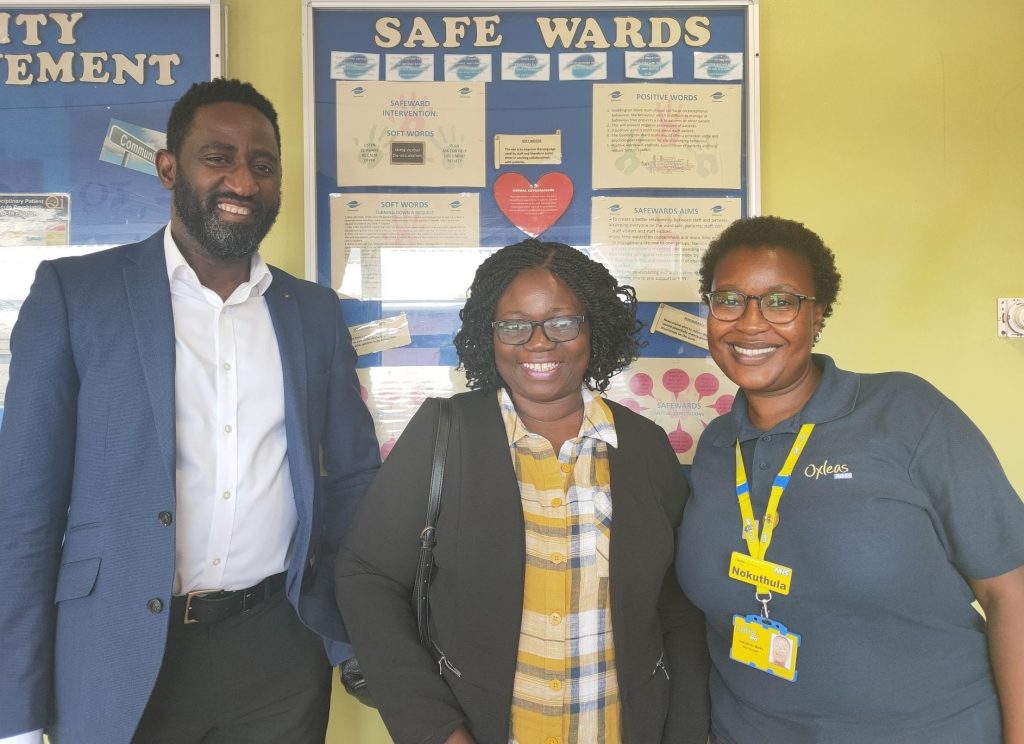Collaborating to reduce restrictive practice: reflections from a visit to an acute psychiatric mental health ward
January 19, 2023Blog
Post Title
Restrictive practices are techniques such as physical restraint, seclusion and rapid tranquilisation used to limit a person’s liberties, movements or freedom to act independently in potentially dangerous situations.
The inappropriate or overuse of restrictive practice in mental health services has been identified as an area of concern in healthcare since at least 2015.
Beginning in 2021, the Health Innovation Network has been involved in local efforts to reduce restrictive practice based on the findings of a successful pilot led by the National Collaborating Centre for Mental Health.
We speak to HIN Patient Safety Project Manager Ayobola Chike-Michael, Practice Development Nurse Nokuthula Marks, and Expert by Experience Igoche Ikwue about the programme team’s recent visit to an acute psychiatric mental health ward and their reflections on how sharing personal experiences and perspectives are key for further reducing restrictive practice.
Ayo
As a patient safety project manager, I know how important it is to involve people and communities in shaping health and care services. The experiences of service users and carers make them experts in their own right and they should be viewed as equal partners – “Experts by Experience” – in improving services and treatments alongside healthcare professionals.
We have worked with Experts by Experience as part of our Reducing Restrictive Practice Quality Improvement Collaborative throughout the project.
Personal perspectives are always enlightening for people like me tasked with helping services to improve, but the insights that have been shared during this project have – being truthful – been emotionally challenging.
Some service users have recounted their experiences of restrictive practice with words like ‘powerless’, ‘dehumanised’, ‘traumatic’ or even ‘haunted’. These words evoke painful, negative experiences and feelings of being actively hurt by the very health and care system that is designed to keep them well.
With these raw emotions in mind, I was nervous about what our planned visit to a local mental health ward might entail.
My experience visiting the ward
During our visit, we met the Ward Manager, some members of staff and inpatients on the ward.
We spoke with the Ward Manager, Nokuthula, for over an hour, opening our eyes to the complex nature of the multidisciplinary team operating at the service and their efforts to look after people living with a range of mental health conditions.
We were taken on a tour around the ward to gain a better feel of how the dynamics of the ward came together; it was positive to see so much interaction between service users and staff.
The atmosphere was calm and peaceful. We observed some service users watching TV, some in the activity room and others in their rooms. We asked many questions as we walked around the ward – not least why anyone would be restrained at all in such an environment.
The ward manager shared some of their own successful change interventions which helped keep the use of restraints low. They talked us through initiatives such as the use of safety pods and the Bröset checklist for risk assessments. An important theme was reflection and evaluation – taking time each month for staff to consider and assess their use of restrictive practices in order to reduce them where possible.
We also talked about how important it was for both staff and service users to be encouraged to share their feelings about life on the ward. Personal relationships based on trust and understanding are vital for everyone involved in the service.
Restrictive practice is a complex issue and does not have one solution.Nokuthula Marks, Ward Manager
Reducing restrictive practice is a complex challenge, but the visit brought home to me that many of the practical interventions making a difference really boil down to doing more to understand and be compassionate towards the people involved, whether through motivating staff and providing staff wellbeing programmes, or creating a psychologically safe environment on the ward through looking at the physical space or ways in which people communicate.
Nokuthula
I’ve spent eight years as a mental health nurse, and more than two-and-a-half as a Ward Manager. Working in acute inpatient settings is something that has always appealed to me; we see people who are very unwell and who have complex care needs, but showing the difference care and compassion can make to their recovery is incredibly rewarding.
Reducing restrictive practice is something that I think everyone involved in delivering mental health care wants to work towards, and over the past two years it has been a real focus for me personally.
The reality of working on a ward does mean it can be difficult to maintain perspective on restrictive practice. It takes conscious effort to avoid becoming “institutionalised” and treating interventions such as medication as being the only option. That is why projects such as the Reducing Restrictive Practice Quality Improvement Collaborative are so valuable – they allow for sharing best practice beyond our busy “day-to-day” lives, allowing us to gain inspiration and confidence from how other people are taking on this big, difficult challenge.
My experience welcoming Ayo and Igoche to the ward
I understand that the view many people have of acute inpatient mental health wards can be quite negative. People worry that these are chaotic, dangerous places. That is why I love having the opportunity to show people first hand the hard work that goes in to making them a positive environment and a place that helps people to recover.
It was so nice to speak with Ayo and Igoche about life on our ward. We shared insights on the approaches that have worked for us such as de-escalation techniques and spotting the early signs of distress to allow for early interventions. We also discussed specific tactics which have helped to make a difference on our ward such as the safety cross, a visual tool for recording uses of restrictive practice and prompting us to think about how we might be able to reduce them going forward.
A common theme for making progress in reducing restrictive practice is building time for reflection into our work. On the ward that can mean scheduling regular time for multidisciplinary team staff to come together in “safety huddles” to discuss recent instances of restrictive practice. In some ways the ward visit itself was an extension of our commitment to reflective practice, and I hope our experiences can aid those working in other services.
I believe that my experiences can be used to help improve mental health services.Igoche Ikwue, Expert by Experience
Reducing restrictive practice is a journey and we still have a long way to go. Our ward is continuing to work hard to be the most supportive environment it can be for our service users; we have just moved to a new, brighter location, which our service users are enjoying. We have also invested in training in “See Think Act” relational security to enable us to use the knowledge and understanding that we have of our patients and apply this to planning and providing care.
As long as we strive to communicate and collaborate, I am confident we will keep on making positive progress in reducing restrictive practice.
Igoche
My experience of caring for a family member who was suffering from poor mental health was very challenging. I was isolated in my own home and it put immense strain on my own health; it was the most difficult time of my life. It makes me sad as I reflect back and recall the lack of support that I needed in times of crisis.
However, I believe that my experiences can be used to help improve mental health services – which is why I am a part of the Reducing Restrictive Practice Quality Improvement Collaborative.
My experience visiting the ward
Like Ayo, I was anxious as I walked through the door of the acute psychiatric ward we were visiting. Despite being an expert by experience, and wanting to help reduce restrictive practice, I had no idea of what to expect.
With that in mind, I was pleased and relieved that common themes running through our conversations on the ward included compassion, kindness, and humanity. We talked at length about the importance of listening and learning from service users.
My time speaking to service users and staff on the ward also made me think about my own experiences. Most service users on the ward have their own families and homes, and in many cases they will have sole carers who can be put under huge strain by the demands of looking after very unwell people. The support on offer from these services needs to extend to families – or else we risk a vicious cycle of mental ill-health and people having to spend more time as inpatients than they should need to.
The visit also gave me insight into the personal connections that underpin services, and how we could seek to improve them to reduce restrictive practice and enable better care for service users.
Whilst staff on the ward seemed to value personal relationships, I wondered if more could be done to “close the gap” between operational staff and senior leaders; understanding service user stories and experiences is of benefit to everyone and should inform decisions being made at all levels.
In the same vein, what else could be done to support staff to develop themselves and bring their best selves to work?
I was particularly struck by our discussions with Nokuthula about staff struggling with being assaulted by service users, and we discussed the importance of consistently and appropriately supporting staff wellbeing.
Personal relationships based on trust and understanding are vital for everyone involved in the service.Ayobola Chike-Michael, Project Manager, Health Innovation Network
Mentoring is another good way to help motivate and inspire staff and provide them with personal support to help to develop their confidence and willingness to try new things.
I also think more should be done to build confidence and skills in communication between team members. For example, activities like lunch-and-learns that showcase hidden talents and hobbies may be helpful, allowing team members to bond over shared or new interests. From my experience teams that engage in fun activities together have a stronger sense of trust and transparency.
Restrictive practice should always be a last resort. My visit to a ward reinforced that focusing on building understanding between staff and service users is really important in making sure it truly remains only a last resort – I hope that more effective communication, engagement and co-production of solutions between everyone involved in inpatient mental health services will continue to reduce its use.
This project is featured in our Annual Report 2022/23.
Find out more about this project in our Annual report 22/23.



